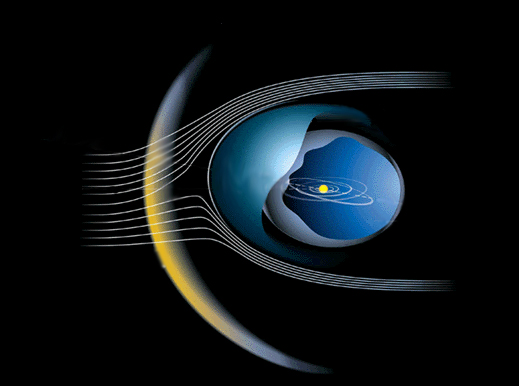| |
RESULTS
Final Stage (2013)
Objectives:
- Apply the model to real time events
Accomplished Activities
- Study of the February 15, 2011 event associated with a CME having as result a 10% probability of triggering a
geomagnetic storm
- Web page design of the data base of studied CMEs.
Stage III (2012)
Objectives:
- Determination of the propagation and real speed of CME associated with solar flares using STEREO data. Better understanding of the triggering mechanisms of CME using new data.
- Developing an empirical model for improving the prognosis of the arrival time of a CME associated with solar flares to Earth.
Accomplished Activities:
- The study of source regions, 3D reconstruction
- The determination of the kinematic properties of CME: real speed,
propagation direction etc, through application of various reconstruction methods. Comparison of these values with recorded values on board of missions from Earth vicinity.
- Analysis of the geomagnetic storms produced by these CME on the variation of geomagnetic indices.
- Developing an empirical model of time arrival of the CME on
Earth prediction, based on the results obtained in previous years and taking into consideration the interplanetary conditions.
Results have been presented to various scientific manifestations and published in specific field reviews (see the publication list).
Stage II (2011)
Objectives:
- Understanting of the triggering mecanism of the geoeffective CMEs
- Determination of correlations between their solar signatures in-situ and of the geomagnetic response
- CMEs analasys from the STEREO era (2007-2010)
Accomplished Activities
- Twenty five major geomagnetic storms (Dst < -150 nT) have been
observed in between 1996-2008 and have been associated with CMEs. 57CMEs could have been producing these storms. That means that most of these CMEs have
interacted in the interplanetary space and have reached the Earth as a complex event (link to the data base).
- The speeds of movement for these CMEs towards the Earth has been
computed supposing that the CME is a sphere that propagates self-similar.
- The time of movement obtained from these speeds and from projected speeds measured
from the LASCO images has been compared with the real time of propagation and it was observed that the best correlation was for the projected speeds. That
let to the conclusion that CMEs propagate with the same speed in all directions and it is possible that what we see in images is the shock that precedes a CME.
- The correlation between ICME speeds and Dst was a small one. The best correlation was
obtained for Dst and Bz measured 2 hours before the minimum Dst. A very small correlation was found in between Dst and the density, temperature of the ICME.
- Only 3 out of the 57 CMEs have been correlated with sunquakes (Besliu-Ionescu et al. 2011)
suggesting the fact that there is no correlation between the CME that produced major geomagnetic storms and sunquakes.
- At minimum solar activity (2007-2010) there have been 21 ICMEs observed to reach Earth, out
of which only 11 have produced moderate and minor geomagnetic storms (Dst between -80 and -30 nT). The correlation between various parameters of ICME and Dst was
very weak. A better correlation was observed in between minimum Dst and ICME speed measured 3 hours before. The most energy from the ICME was injected in the
magnetosphere in the main phase of the geomagnetic storm. The high speed streams have played a major role in producing these storms (Maris et al. 2011).
Results have been presented to various scientific manifestations and published in specific field reviews (see the publication list).
Stage I (2010)
Objectives:
- Analysis of historic CME events associated with solar flares that produced major geomagnetic storms, in the period 1996 - 2008.
Accomplished Activities
- Selection of the solar events using on-line images/movies
- Project web page initiation
- Creation of the catalogue of these events, comprising: near-Sun signatures (source region, speed, mass, kinetic energy etc.),
in-situ (near-Earth) signatures (speed, magnetic field orientation, density, temperature etc.), geomagnetic response (Dst index).
Results have been presented to various scientific manifestations and published in specific field reviews (see the publication list).
|
|
